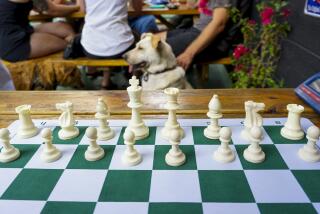CHESS
- Share via
Jan. 14, 2001
Position #5620: White to play and win. From the game Arencibia - Huerta, Mexico 2000.
Solution to Position #5619: Black breaks through with 1 . . . Nxe5! 2 Nxe5 Rd2+ 3 Kg1 Ng5, threatening 4 . . . Nxh3+ 5 Kh1 Rf1 mate. If 4 Nc3, then 4 . . . Rff2 5 Ng4 Nf3+ 6 Kh1 Rh2+ 7 Nxh2 Rxh2 mate.
INTERNATIONAL NEWS
New world champion Vladimir Kramnik defeated fifth-ranked star Peter Leko, 7-5, in a match of 25-minute games in Budapest. Leko rallied from a 1-3 deficit to tie the match at 4-4, but lost the next two games last Sunday. Two draws on Monday clinched Kramnik’s victory.
Few of the games were memorable. But Leko did manage to defeat the Berlin Defense to the Ruy Lopez, the opening that Kramnik used so successfully in his November world championship victory over Garry Kasparov.
The players revealed opposing attitudes to rapid chess in the time scrambles at the end of the seventh and 10th games. In both cases, Kramnik had a nominal advantage that Leko neutralized easily. In the seventh game, Kramnik, with only five seconds remaining, offered a draw to Leko, who had 23 seconds left. Leko graciously accepted. In the 10th game, Kramnik had the edge on the clock and kept playing a drawn position until Leko ran out of time.
RWE Gas, a German company that sponsors Leko, organized the match.
The Corus tournament, probably the greatest chess event of the year, has begun in Wijk aan Zee, Netherlands. The 14-player round robin brings together Kramnik, Kasparov and new World Chess Federation (FIDE) champion Viswanathan Anand. For live coverage, go to:
www.corusgroup.com/coruschess.
Anatoly Karpov has ended his dispute with FIDE. Karpov, who won FIDE’s controversial world championship title in January 1998, complained when FIDE unexpectedly cut his two-year reign by switching to an annual championship in the summer of 1999. In a decision reached Tuesday at the Court of Arbitration for Sport in Lausanne, Switzerland, Karpov accepted $50,000 from FIDE and agreed to recognize Alexander Khalifman as FIDE’s 1999 champion and Viswanathan Anand as FIDE’s 2000 champion.
Politics have tainted FIDE’s January ratings list. FIDE chose not to rate the Braingames Network match between Kasparov and Kramnik, a match that most fans consider the true world championship. Ironically, FIDE’s decision helps Kasparov, for many years FIDE’s worst enemy. Kasparov remains atop the January list at 2849, far ahead of #2 Anand (2790) and #3 Kramnik (2772). A rival list issued by the remnants of Kasparov’s former organization places Kasparov and Kramnik in a tie for first place at 2792.
LOCAL NEWS
Richard Henderson won last Sunday’s tournament at Chess Academy in Hollywood. Steve Labollita achieved a draw against grandmaster Eduard Gufeld in a simultaneous exhibition. The club will repeat the two events today at 11 a.m. and 3 p.m. For information, call Gufeld at (323) 883-0164 or (323) 512-4564.
The Exposition Park Chess Club hosted two tournaments last Sunday. Ramon Tolentino swept a quad with a perfect 3-0 score, and Stefanie Botelho led a Swiss system with 2 1/2- 1/2. Next at 2-1 were Leland Farrar and Simon Howard. The club meets at 1 p.m. Sundays in the public library, 3665 S. Vermont Ave. in Los Angeles.
The Chess Center, 2651 Irvine Ave. in Costa Mesa, will conduct tournaments and chess classes on Wednesday and Thursday evenings. For details, call (949) 646-6696.
TODAY’S GAMES
GM Plaskett (England) - GM Bischoff (Germany), Hastings 2000-2001: 1 e4 c5 2 Nc3 e6 3 Nf3 Nc6 4 Bb5 A tricky anti-Sicilian system that relies on quick development. Nge7 5 0-0 a6 Most logical, although it accentuates White’s lead in development. Safer is 5 . . . Nd4. 6 Bxc6 Nxc6 7 d4 cxd4 8 Nxd4 Qc7 Correctly avoiding 8 . . . d6 9 Re1 Be7 10 Nxc6 bxc6 11 Qg4 0-0? 12 Bh6 Bf6, when 13 e5! dxe5 14 Rad1 Qe7 15 Ne4 gives White a terrific attack. 9 Re1 Nxd4 Black has also experimented with 9 . . . Bd6 10 Nxc6 dxc6 11 Qh5 e5. 10 Qxd4 f6 11 e5 f5 12 Bg5 b5 13 Rad1 New. In Christiansen - Bischoff, Germany 1999, Black equalized easily after 13 Qh4 Bb7 14 Ne2 Bc5 15 Rad1 0-0 16 Nf4 Be4 1’7 c3 Rf7. Bb7 14 Rd3 b4 Probably best. If Black rushes to castle with 14 . . . Bc5 15 Qh4 0-0, it’s uncertain if he can survive 16 Rh3 h6 17 Bxh6 gxh6 18 Qxh6 Kf7. 15 Ne2 Be4?! Black should risk 15 . . . Bc5 16 Qh4 Qxe5. White can preserve his e-pawn by 16 Qf4, but 16 . . . h6 17 Qh4 Kf7 18 Bf4 Rag8 19 Be3 Be7 prepares a counterattack with . . . g7-g5. 16 Rdd1 Bc5 17 Qd2 Qb7 Black hopes to maneuver quietly, but White will not cooperate. The bold 17 . . . Bxc2!? 18 Rc1 Be4 appears too dangerous after 19 Ng3 Qxe5?! 20 Bf4 Qd4 21 Qe2 Be7 22 Red1 Qb6 23 Nxe4 fxe4 24 Qh5+ g6 25 Qe5, but 19 . . . Bb7 (threatening 20 . . . Qc6) 20 Be3 Bxe3 21 Qxe3 Bc6 22 Nh5 0-0 isn’t so clear. 18 Nf4 Rc8 After 18 . . . h6? 19 Ng6, neither 19 . . . hxg5? 20 Nxh8 Bxg2 21 Qxg5 nor 19 . . . Rg8 20 Be3 Bxe3 21 Rxe3 Kf7 22 Rg3 solves Black’s problems. 19 Nh5 Rg8? Too meek. Also 19 . . . 0-0?! 20 Qxd7 Rf7 21 Qxe6 Bxg2 22 Nf4 Be4 23 Qb3 Kh8 24 e6 leaves White in charge. But 19 . . . Bxg2 20 Nxg7+ Kf8 21 Qxd7 Qxd7 22 Rxd7 Bd5 complicates White’s task. For example, 23 Bh6 Rg8 24 Rd1 Be7! (White welcomes 24 . . . Bc6? 25 Kf1 Bxd7 26 Rxd7) 25 Kf1 Bc4+ 26 Ke1 Kf7 27 Bg5 Kxg7 offers Black counterplay. 20 Rxe4! An intuitive sacrifice that eliminates Black’s most active piece. fxe4 21 Qf4 Ba7?! Neglecting defense of d6 and e7 to make a threat against c2 that White blithely ignores. Worse is 21 . . . Be7? because 22 Bxe7 Kxe7 23 Nxg7! Rgf8 24 Qg5+ Kf7 25 Nh5 wins. Only 21 . . . h6 puts up a fight. White can draw by 22 Bxh6 gxh6 23 Nf6+ Ke7 24 Qh4 Rgf8 25 Nxd7+ Ke8 26 Nxc5 Qe7 27 Qh5+ Qf7 28 Qh4 Qe7 29 Qh5+ or try for more with 22 Bh4 g5 23 Nf6+ Kf7 25 Qc1! Rgd8 26 Bxg5. 22 Bh4 Inviting 22 . . . Rxc2 23 Qg5. h6 23 Qg4 Kf7 Now 23 . . . Rxc2 loses instantly to 24 Qg6+ Kf8 25 Nf6! Bxf2+ 26 Kh1. 24 Ng3 Rc4 This time, 24 . . . Rxc2 allows the deadly 25 Nxe4 Bb8 26 Qf3+ Kg6 (or 26 . . . Ke8 27 Nf6+) 27 Qd3. 25 Nf5! As 25 . . . exf5 26 Qxf5+ Ke8 27 e6 mates. Bc5 26 Qh5+ Kf8 If 26 . . . g6 27 Nxh6+ Kg7, White regroups for the final assault by 28 Qg5 Rf8 29 Ng4. 27 Rd6! Menacing 28 Be7 mate. exf5 Or 27 . . . g5 28 Qxh6+ Ke8 29 Qh7. 28 Qxf5+ Ke8 29 e6 Bxf2+ 30 Bxf2, Black Resigns.
Molander (Sweden) - IM Ornstein (Sweden), Stockholm 2001: 1 e4 e5 2 f4 The ancient King’s Gambit. exf4 3 Bc4 Nf6 4 Nc3 Bb4 Theory claims that 4 . . . c6! 5 d4 d5 equalizes. 5 e5 Or 5 Nf3 Nc6 6 Nd5, with an edge to White. d5 6 Bb5+ c6 7 exf6 cxb5 8 fxg7? Helping Black develop his Rook. In 1862, Paulsen showed that 8 Qe2+ Be6 9 Qxb5+ Nc6 10 Nf3 Qxf6?! 11 Qxb7 Rc8 12 Nxd5 favors White. Rg8 9 Qh5 Rxg7 10 Nxd5? Falling further behind in development. Nc6! Avoiding 10 . . . Bg4?? 11 Qe5+ Kf8 12 Nxb4 and 10 . . . Rg5?? 11 Qe2+ Be7 12 Nf6+ Kf8 13 Nxh7+. 11 Nxb4 Qe7+! 12 Kf2 White is already lost. If 12 Qe2 Nxb4 13 Kd1, then 13 . . . Bg4 14 Nf3 Qxe2+ 15 Kxe2 Nxc2 16 Rb1 Bf5! 17 Kf2 Nb4 18 Ra1 Nd3+ 19 Kf1 Rc8 embarrasses White’s Bishop. Nxb4 13 Qxb5+ Bd7 14 Qe2 After 14 Qc4 Rc8 15 Qd4 Kf8, Black invades at c2. Nor does 14 Qxb7 Qc5+ 15 Ke2 Bc6 help White. Nxc2 15 Rb1 Just as bad are 15 Qxe7+ Kxe7 16 Rb1 Nb4 17 Nf3 Nd3+ 18 Ke2 Bb5 and 18 Kg1 Rc8. Be6 16 b4 Nd4 17 Qe4 If 17 Qd1, one method is 17 . . . Qh4+ 18 Kf1 Qg5. Rxg2+! Seeing 18 Qxg2 Qh4+ 19 Kf1 Bb5+. 18 Kxg2 Bh3+ 19 Nxh3 Qxe4+, White Resigns.

